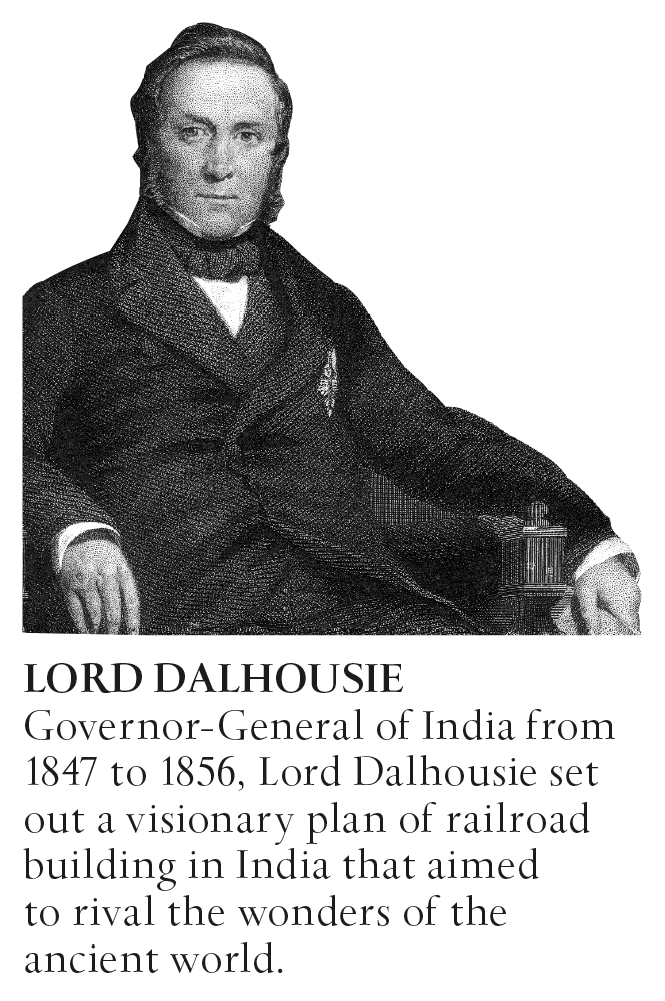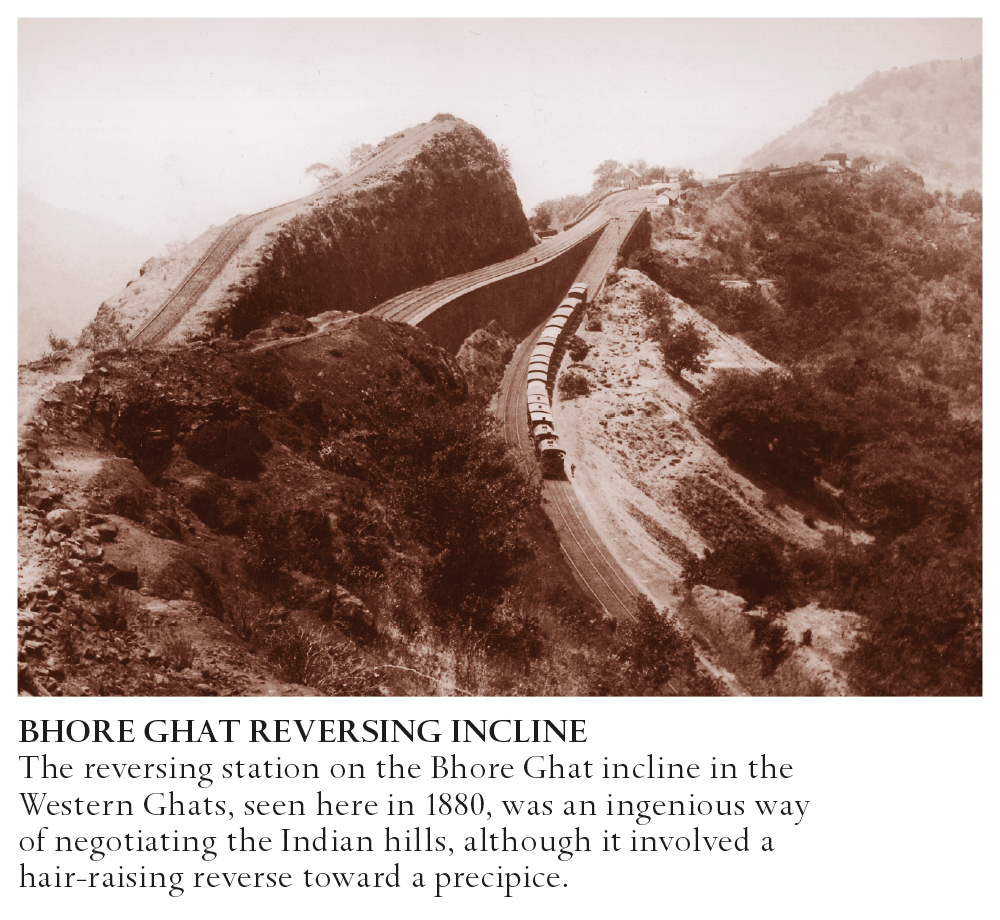India: Dalhousie’s Colonial Imperative
India was the jewel in Britain’s crown during the 19th century, and its colonial rulers were eager to impose their dominion over the subcontinent. The railroads were vital to this process and were brought to India by the British East India Company—effectively a commercial arm of the British government. The first Indian railroad, which ran from the company settlement of Bombay, was commercial in aim, prompted by events on the other side of the world: the American cotton harvest had failed in 1846, and this spurred the cloth manufacturers of Manchester to use India as an alternative source of cotton. However, in order to ensure the steady supply needed to keep their factories running, transportation to the Bombay port needed improving, and so the cotton magnates pressed the British government to build a railroad.
Due to bureaucratic delays—it took months to receive a reply to a letter sent from India to Britain—and indecision on the part of the British rulers, work on the 21-mile (34-km) line between Bombay and Thane, or Tana, did not start until 1850. It was an experiment to see if it was possible to build railroads in the harsh climate of the Indian subcontinent. The Thane line was not easy to construct. Now part of Bombay’s busy suburban network, it originally went through difficult territory, including a hill that had to be cut through and a marsh. Nevertheless, it was completed in three years.
The opening of the line in April 1853 was a momentous affair, not least because it was the first railroad in Asia. Unlike northwest England, where railroads had originated, India was still a rural, unindustrialized nation, and the sight of powerful locomotives belching fire and steam impressed and frightened the local populace in equal measure. People lined the tracks by the millions to watch the 14-passenger car train bearing a rich assortment of VIPs on its inaugural journey, and many spilled onto the tracks, slowing the progress of the train, which nevertheless managed the journey at an average speed of 20mph (32kph)—a very creditable effort.
Another, more ambitious, project started simultaneously in Bengal, in the northeast of India. This was a 121-mile (195-km) line stretching from Howrah, on the western side of the Hooghly river, via nearby Calcutta to the small town of Raniganj in the coalfields of Burdwan, from which it had previously taken two seasons to cart the coal down to a river for transportation to the rest of the country. Work on the line started in 1851, but a couple of shipping mishaps delayed progress. First, the passenger cars intended for the line were lost when the ship carrying them sank at Sandheads on the Bengal coast, and then, astonishingly, the locomotives for the line were sent to Australia instead of Calcutta as a result of one of the most expensive clerical errors in history. The locomotives eventually arrived in Calcutta—a year late—but, despite these setbacks, the line, nearly six times longer than the Bombay–Thane railroad, opened in February 1855.
The success of these two lines led to a rapid expansion of the railroad system. Unlike in Britain, where the process was unplanned and haphazard, the development of the rail network in India followed a clear plan laid out by the colonial administration. In 1853, Lord Dalhousie, the governor-general, set out a program for the development of India’s trunk lines in a 216-page handwritten memorandum. Dalhousie was a hard-working, capable administrator who later claimed to have given India all the necessary “engines of social improvement… Railways, uniform postage, and the Electric Telegraph.” His “minute,” as he called the memorandum, set out the justifications and guidelines for the railroads of India, whose territory then included what is now Bangladesh and Pakistan.

Dalhousie emphasized the economic benefits that the railroads would bring. They would increase trade between India and the mother country—Britain importing cotton and India receiving manufactured goods in return. Railroads would encourage enterprise, increase production, facilitate the discovery of natural resources such as coal and minerals, and encourage overall economic development as they were doing in Europe and the United States, which were now both three decades into the railroad age. However, the core of Dalhousie’s argument was not commercial but political. The British administrators and soldiers who ruled the country were thinly spread, and railroads would enable them to travel rapidly to maintain control—an advantage that was worth almost any price.

For his part, Dalhousie was nothing if not a visionary. In his minute, he wrote enthusiastically:
the complete permeation of these climes of the sun by a magnificent system of railway communication would present a series of public movements vastly surpassing in real grandeur the aqueducts of Rome, the pyramids of Egypt, the Great Wall of China, the temples, palaces and mausoleums of the great Moghul monuments.
An exaggeration, perhaps, but it gives an idea of the enormity of the plan. Dalhousie’s blueprint was given urgency by a mutiny of the army’s Indian soldiers that began in May 1857 and threatened colonial rule. The mutiny—which began with soldiers refusing to bite on musket cartridges covered with tallow made from either beef fat (offensive to Hindus) or pork fat (offensive to Muslims)—had broken out in remote parts of the country. The military realized that rather than bringing vast numbers of British troops over to manage the Indian regiments, it was cheaper to build railroad lines to ensure that troops could be despatched at speed to deal with insurrections wherever they happened. The mutiny halted work on railroad projects across India, but work recommenced at a faster pace when peace was restored in June 1858.

The railroads, in other words, were a nakedly colonial project that paid scant regard to the needs of the native population. The British decided on the location of the lines and when they would be built. They were designed to serve British interests and would later be seen by nationalists such as Mahatma Gandhi as agents of imperialism. The British government accepted Dalhousie’s plan and the railroads were constructed to the pattern he had devised. Major trunk routes radiated from the port cities and centers of colonial administration, such as Calcutta, Bombay, and Madras, and further lines connected other large towns and cities. It was, as one writer suggests, a period of great “romance and excitement,” but it was also a time of hardship, particularly for innumerable Indian workers, thousands of whom died constructing the railroads. The country’s diverse and rugged landscape also posed formidable challenges. Bridges, for example, had to withstand far greater pressures than those of Europe, because the monsoon rains made rivers swell to enormous, and destructive, proportions.

The Western Ghats, a chain of mountains that run down much of the western side of the subcontinent, proved to be an almost insuperable barrier. Although not immensely high—a mere 8,840ft (2,695m)—they rise sharply and ruggedly beyond the narrow coastal lowlands, presenting what at the time was the most difficult section of railroad terrain in the world. It took engineer James Berkley several years just to survey the route, although the line was only 15 miles (24km) long. When it was finished, the line featured two major inclines (see Going Uphill)—the Bhore and the Thul Ghats—as well as numerous tunnels. Berkley devised an ingenious way of overcoming the steep grade. Instead of building a continuous track, he carved out a reversing section at a bend near the summit, obviating the need for a stationary engine to haul the trains uphill. It was a cheaper and neater solution than a conventional route, and was imitated on several other mountain lines, notably in Brazil and the Andes. The system involved driving a train along a narrow line toward a precipice, so it required nerves of steel on the part of the engineer, and indeed the passengers.

To create the track bed for the Ghat line, whole sections of the mountain had to be blasted and workers let down on ropes to drill into the mountain face—a perilous process. On numerous occasions, the ropes failed or slipped, sending workers down into a ravine from which their bodies were never recovered. Illness, however, was the biggest killer. Numerous killer diseases, including typhoid, malaria, smallpox, cholera, and blackwater fever, took a high toll on the overworked and undernourished workers, who died by the tens of thousands. The lives of the Indian workers, or “coolies,” as they were known, were considered cheap in Colonial India. As one government report tellingly reads:
The fine season of eight months [work except in tunnels halted during the monsoon] is favourable for Indian railway operations, but on the other hand, fatal epidemics, such as cholera and fever, often break out and the labourers are generally of such feeble constitution, and so badly provided with shelter and clothing, that they speedily succumb to those diseases and the benefits of the fine weather are, thereby, temporarily lost.
As Anthony Burton, the author of a book on railroads and the British Empire, observes: “the notion that lives—and the inconvenient loss of working time—could be saved by providing proper shelter and decent conditions does not seem to have been considered.”
The spread of the railroad in India came at a high cost, but it remained a remarkable achievement, and Dalhousie’s plan was adhered to long after his departure and death. His belief that the project would be bigger than the construction of the pyramids was borne out. Within 25 years of the opening of the Thane line, India had an extensive network of trunk lines. By the turn of the century, there was a remarkable 25,000 miles (40,000km) of track—a network that has survived to this day with few closures, and which remains a key part of the infrastructure of a nation in which a highway network was only developed late in the 20th century. The Indian railroads have become synonymous with India itself.